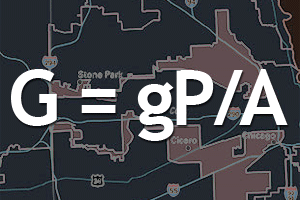
Flickr/<a href="http://www.flickr.com/photos/theredproject/3032688699/">mandiberg</a> (<a href="http://www.creativecommons.org">Creative Commons</a>).
Right now, the politerati are focused on the House of Representatives. Will the GOP win enough seats (39) to take control and boot Nancy Pelosi from the Speaker’s chair, or will they fall short? Here’s what you may not know: the results of the November elections can be undermined—or set in stone—by the US Census.
The results of America’s nationwide head count determine the number of congressional districts in each state—and, consequently, those states’ electoral votes in presidential elections. It’s fairly simple: To calculate how many electoral votes a state is worth, simply count the number of congressional districts in the state and add two—one for each senator. House seats and electoral votes are transferred from slow-growing states to faster-growing ones after each census.
The latest estimates of which states will gain and lose seats (and electoral votes) came out this week. The bottom line is that the results aren’t good for Barack Obama and the Democrats. Solid blue states New York, Illinois, Pennsylvania, Massachusetts, Michigan, and New Jersey—states that have gone for the Democrat in every presidential election since 1992—are set to lose seven electoral votes. Washington is the only reliably Democratic state that is poised to gain a seat. Meanwhile, solid red states Georgia, South Carolina, Texas, and Utah are set to gain a net seven electoral votes. Louisiana, which Bill Clinton won twice but has been a solid red state since Katrina, will lose a seat. There are changes going on in key swing states, too. Arizona and Nevada are both set to gain a seat, and Florida will gain two. Iowa and Missouri, meanwhile, will lose a seat each—and Ohio, long a national bellwether, will lose two.
Blue states losing six electoral votes and red states gaining six isn’t exactly a disaster for Democrats. The big fight, however, will be over congressional redistricting. That process—which will force some incumbents out of their jobs and protect many others—is controlled by the states. Governors play a role, but most of the work is usually done by state legislators. Whichever party controls the legislature generally gets to draw the maps.
To avoid getting totally shafted in the redistricting process, the key is to control at least one of the three main pivot points of redistricting—the governor’s office or one of the two legislative chambers. A party with full control of a state’s legislative and executive branches will have the ability to run wild with redistricting. Right now, the GOP is threatening to do just that in a number of key midwestern states.
Republicans have a real shot of controlling the entire redistricting process in Indiana, Ohio, Pennsylvania, Michigan, and Wisconsin. If the GOP can sweep those contests, Republicans can cut the heart out of any potential Democratic House majority going forward. Republicans either hold the governorship or lead in the polls in the gubernatorial races in all five states. And while Democrats hold at least one legislative chamber in each of the five states, the party’s hold on these majorities is tenuous.
Between the current GOP-drawn maps in Michigan and Pennsylvania, the Tom Delay-led Texas gerrymander of 2004, and other supposedly unfair maps around the country, the strategists at the Democratic Legislative Campaign Committee—which helps Dems in state legislative battles—figure that the national House map is already tilted towards the Republicans by some 25 seats. Republicans have estimated that they could turn 25 more their way via redistricting.
If the Republicans fall just short of a majority in 2010, they could use redistricting to ensure they gain back the House in 2012. Or, if they make huge gains, they can use redistricting to lock them in. “If you care about a progressive future for the next decade, you can’t allow Republicans to control this process,” says Michael Sargeant, the executive director of the DLCC.
If redistricting were held today, the GOP wouldn’t control the process—far from it. Nationwide, Democrats currently control 60 state legislative chambers. Republicans control just 36. But 21 legislative chambers in 17 states are within five seats of flipping. Most of the those narrow majorities are held by Democrats. And some of the most competitive state legislative fights will occur in states that will gain or lose seats in the census. Here are some of the top legislative races around the country:
- Ohio House: Dems hold a small majority, and Dem Gov. Ted Strickland is trailing in the polls. If the Ohio GOP takes the House, it will totally control the redistricting process.
- Pennsylvania House: Same deal as Ohio. The Dem gubernatorial candidate is trailing, and Republicans think they’ll probably control all three pivot points come January.
- New York Senate: Democrats hold a razor-thin majority. But their gubernatorial candidate, Andrew Cuomo, leads, and they have a lock on the lower chamber. If they can hold on in the Senate, they’ll totally control redistricting here.
- Arizona House and Senate: Republicans control both chambers and are leading in the gubernatorial race. Dems have to win one of the two chambers if they want to have a voice in how Arizona’s new House seat gets drawn.
- Texas House: Dems only need to win three more seats to take control of the House. (My colleague Suzy Khimm wrote a great piece on the Dems’ Texas effort for the last issue of the magazine.) They also have a shot at the governor’s race. They could, of course, lose both, and have no say in redistricting. Texas is already very Republican-gerrymandered—but it’s also gaining four seats. This is a very high-stakes fight.
- Colorado House: Dems hold a small majority here, and this state is set to gain at least one seat.
How do we know that the redistricting will dramatically affect the results in 2012? Because this has happened before. Of the 39 seats that switched hands in 2002 and 2004, the DLCC estimates that 23 were heavily affected by redistricting.* In a closely-divided House of Representatives, that could easily be the difference between Speaker Boehner and Speaker Pelosi.
*I corrected the numbers in this sentence, which originally said 17 of 19. That was wrong. Sorry.











